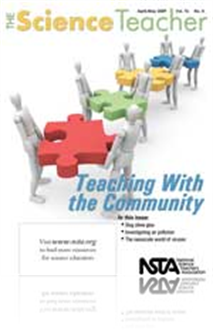All The Science Teacher resources
Journal Article
For many years, publications such as the National Science Education Standards (NRC 1996) and The Science Teacher (TST) have encouraged teachers to focus science classes more heavily on inquiry-based instructional practice. One way to improve our teac...
Journal Article
Editor’s Corner: Outside the School Walls
This issue of The Science Teacher (TST) continues our tradition of devoting one issue each year to partnerships that connect students, teachers, and their communities. Science activities that take students outside school walls can combine the best as...
Journal Article
Idea Bank: Vector, Vector—That’s Our Cry!
There are all kinds of computer-based software programs and websites available to help students understand and manipulate vector quantities. But if you have the time and want to do something different, this Idea Bank describes an easy, low-tech, and ...
Journal Article
Safer Science: Biosafety—Getting the Bugs Out
Basic knowledge and adoption of biosafety guidelines, including disinfection and sterilization techniques, are a necessary component in high school biology laboratories. This is especially important if students or instructors are working with growing...
Journal Article
The Prepared Practitioner: An Assessment Primer
Although the title of this month’s column may make your skin crawl—read on. Everyone should understand a few basics about the “A” word. Being able to distinguish formative from summative assessment and criterion-based from norm-referenced tes...
Journal Article
Collaboration at the Nanoscale
The Maine ScienceCorps is a project sponsored by the National Science Foundation’s (NSF) Graduate Teaching Fellows in K–12 Education (GK–12 ) program. Through this program, the University of Southern Maine’s (USM) virology and transmission el...
Journal Article
Secondary science teachers are faced with an increasing number of students whose first language is not English and charged with preparing them for federal- and state-mandated end-of-course exams. In many states, these high-stakes tests play a crucial...
Journal Article
Classification and the Dichotomous Key
Classification is a vital science-process skill for all students to master. Understanding dichotomous keys as a means of classification enables students to better comprehend large amounts of information and understand how to organize, compare and con...
Journal Article
The Prepared Practitioner: Multiple-Choice Season
Spring is almost here. Soon buds will appear on trees, and bubbled-in answers will appear on test response sheets all across America. Spring brings a spate of multiple-choice tests for many students—from SATs to AP exams to final exams to state and...
Journal Article
Idea Bank: Astronomy for Students With Sensory Impairments
The Space Exploration and Experience (SEE) Project and Yerkes Astrophysics Academy for Young Scientists (YAAYS)—both at the University of Chicago’s Yerkes Observatory in Williams Bay, Wisconsin—are designed to promote active learning in astrono...
Journal Article
Teaching With Multiple Methods in Mind
Teachers know what a daunting job it can be to ensure that all students in a class learn effectively. In addition to the usual difficulties of gaining everyone’s attention at once, instructors also run into the issue of preferred learning styles. I...
Journal Article
My students are on their cell phones all the time! Do cell phones really harm the brain? And what about the teen brain? ...
Journal Article
Your students successfully completed a lab session, correctly filled in all of the worksheets, and collected the required data. Yet, as a science teacher, you still find yourself wondering—what did my students actually learn? And, can they apply t...
Journal Article
Challenges and Solutions for ELLs
Preparing students for high-stakes testing presents a constantly increasing challenge for science teachers. Not only do students vary greatly in their science knowledge and backgrounds, but also English Language Learners (ELLs) are often placed in ma...



